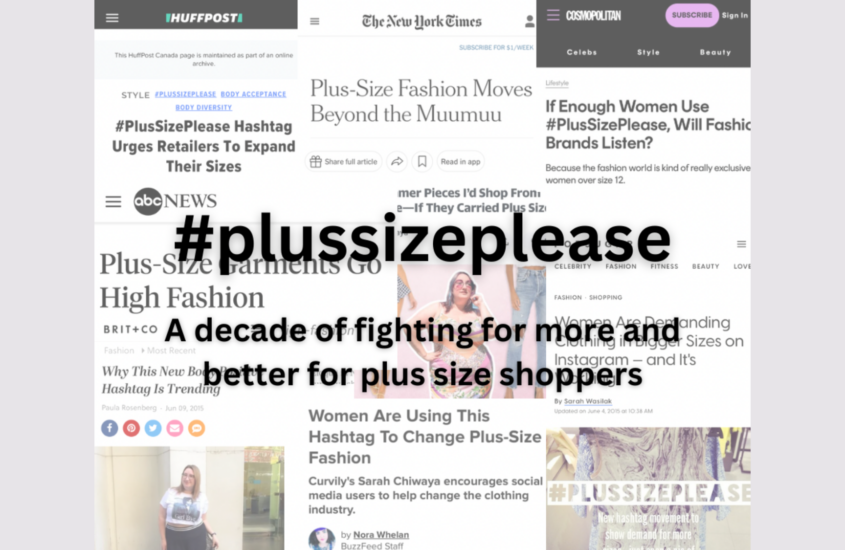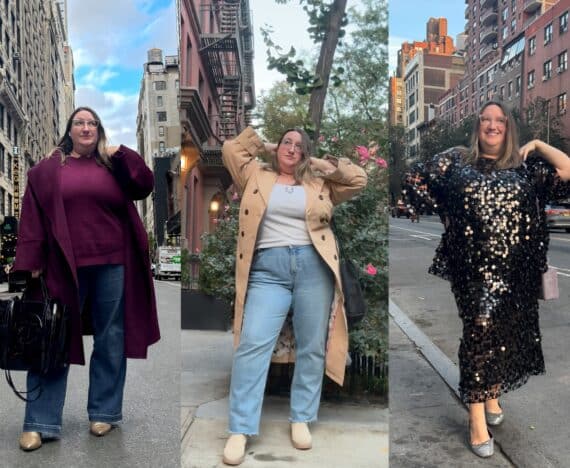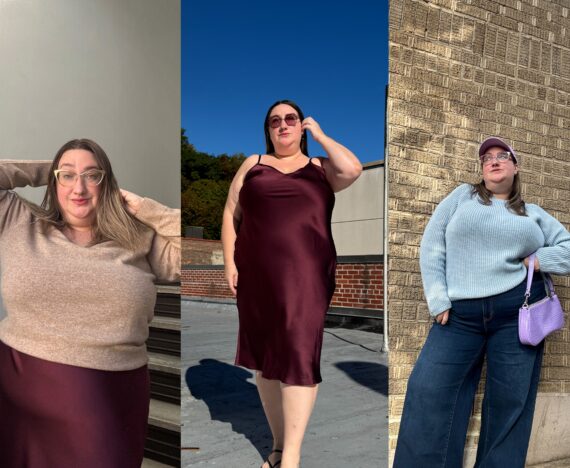10 Years of #PlusSizePlease: The Fight for More and Better for Plus Size Shoppers

I can’t believe it’s been a full decade since I first used the hashtag #plussizeplease to request that stores expand their size ranges.
It started out as a just an Instagram comment, responding to a friend who asked if the skirt I posted came in plus. When I tapped out the hashtag on my phone, I didn’t intend to start a movement. But the more I thought about it – and the more I saw the enthusiastic response I got from followers and peers – I realized that I might have tapped into something bigger. So I drafted up a set of guidelines and officially launched the #PlusSizePlease hashtag movement on April 16, 2014.
Since then, #PlusSizePlease went on to become a viral social movement, with thousands and thousands of women using it the hashtag to tell brands directly that they would love to be spending money with them, if only they’d actually make our sizes.
The movement was written up in the New York Times, in a Buzzfeed article (back when Buzzfeed was truly at the height of its powers), Cosmo, the Huffington Post, CNBC, Fashionista, and was even featured in national broadcast news on ABC. It’s spawned copycat hashtag movements, been cited in scholarly articles and books (including Gianluca Russo’s excellent history The Power of Plus), and inspired others to take action to fight for a better fashion world for all sizes.
I always say that our power is in our community – plus size women are the majority market, after all – and I always intended #plussizeplease to be a way to harness that power and help brands hear our voices. One thing I’ve been saying for years is that plus size shoppers are not a monolith: Just like the straight size market has brands that cater to varied aesthetics, budgets, and shoppers (think about the difference in customer bases for Free People, Ralph Lauren, The Frankie Shop, Loewe, Athleta, and H&M, and Rainbow, for example), there are plus size women across the style spectrum who want to be able to spend our money on clothes we actually like.
In the decade since #plussizeplease launched, I’ve watched the fashion industry ebb and flow when it comes to size inclusion. At the beginning of 2020, I was very excited for the future of plus fashion. Many brands were rolling out extended sizes and plus fashion lines that weren’t a watered down version of the aesthetic they are known for. We were getting more in store options (something that is SO important for developing a loyal plus size customer base), and the future seemed bright. But then COVID hit, and for many brands, it seemed to offer an easy out from serving a market they never really cared about.
We’ve since seen other brands venture into the plus size market only to back out immediately, and I have serious concerns that the industry is taking the wrong cues from these half-assed attempts. Nowhere else in the business world would a brand try to step into a new market by relying on one lone ad campaign (or less) and then giving up in less than a year. As I was discussing on Threads recently, the “if you build it, they will come” approach is not a real marketing strategy (leave that to fictional Kevin Costner ballfields, thank you very much).
But as much as some brands try to pass off their lackluster plus size rollouts as a lack of a viable market, the actual data and analytics prove otherwise. All of the extensive market research done in the industry shows that not only is the plus size market the most populous (over 67% of women are in the plus size range), it is growing at twice the rate as the straight size market. And that growth not starting from scratch, either: The plus size market is already valued at $541.35 billion – yes, that is billion with a b – and it is forecasted to grow to over $727 billion USD in the next five years alone. The potential is massive and largely untapped, with only 20% of clothing made offered in sizes that fit the majority of women. And the brands that have recognized that potential and actively courted the customer base, the gains are more than significant: Christian Siriano, for example, tripled his business by offering plus sizes – and importantly, he also consistently includes plus models on the runway and dresses plus size celebrities. In short, he treats customers of all size with the same care and respect, and that pays off.
When I started #plussizeplease 10 years ago, only a handful of brands offered plus that was actually fashionable. The options were scant across the board, from fast fashion to designer. The conversations about inclusion weren’t happening at the same rate and frequency, and we didn’t have the same data to back up our requests to be served as customers. There was also a real lack of awareness on the brand side – most schools didn’t even mention size inclusion in their curriculums, let alone teach designers how to drape and scale for larger figures. And while things are far from perfect in 2024, that is no longer the case.
Because we’ve used our voices collectively, pretty much every brand now has at least some knowledge of the demand for plus (even if they aren’t accurately comprehending just how widespread and valuable it is). That has led to more brands actually stepping up and expanding their size ranges, and we have so many more labels to shop now.
However, the reality of the other side of that coin is a lot less fun: A lot of these brands have heard our demands loud and clear, have seen the statistics and success stories, and still refuse to make clothing for the majority. So where does that leave us and #plussizeplease, a decade into its existence?
For me, the best approach is three pronged:
- Support the brands that support us! There are SO many good options that make plus sizes now – and I love to feature them here and on my Instagram. I have a lot of in-depth researched guides on where to find great plus size options for everything from workwear to swim to linen, and I have a huge guide to the best size inclusive brands coming soon too. Supporting these companies with our purchases helps them continue to exist and give us the options we’ve been demanding.
- Recognize small businesses making a good faith effort (and encourage them to continue to expand with #plussizeplease). Adding sizes isn’t as simple as just grading up a pattern – it does take upfront investment to get the fit and sizing right, and that can be prohibitive for small businesses who are just getting started. So I appreciate when they take the initiative to serve as many sizes as they can now, while committing to continuing to expand as they can. Designer labels like Melke and Sam Finger come to mind – they are both emerging designers who currently go up to around a size 20, but they are mindful about representing their full size range in their NYFW shows and in their campaigns. I love both of their designs, and want them to continue to be able to flourish and grow so they can add sizes without breaking themselves.
- Hold big brands accountable (and demand #plussizeplease or bust) If small designers with teams under 5 people can manage to serve a broad range of sizes, there is truly no excuse for multimillion corporations not to at least be on par with them. I’ve personally stopped shopping at retailers who dig their heels in when it comes to the demand for plus. If I see something I really love and can’t find elsewhere from a brand that actually cares about plus shoppers, I’ll tag the with a #plussizeplease and remind them how ridiculous it is to be leaving all this money on the table.
I am also happy to use my platform to amplify our calls for more and better options in plus, so please tag me (@curvily on all platforms) if you use #plussizeplease to call out a brand, and I’ll share!



